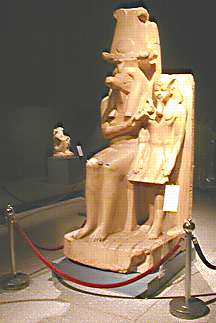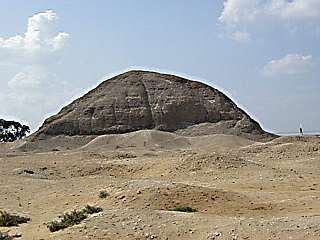The Faiyum
The Faiyum, a large oasis located about forty miles south-west of Cairo, is the only Egyptian oasis fed
directly by the Nile. Much larger in antiquity than it is now (though still a very large lake) Birket Qarun
(ancient Lake Moeris) is surrounded by some of the most fertile land in Egypt and, as such, supported large numbers
of people. At times the population size of the Faiyum rivaled that of the entire Nile Valley.
The kings of the Middle Kingdom constructed major hydraulic works
that actually raised the level of the lake
several feet above sea level. Through the New Kingdom and on into Greek and Roman times, the Faiyum continued to be a
major source of economic prosperity. The marshy land around Birket Qarun (the lake has no outlet) not only was favorable
for agriculture but was also a perfect habitat
for crocodiles (prehistoric reptiles that are now all but extinct within Egypt) and other fauna, which made the area a favorite
hunting ground for pharaohs from the earliest times.
The large population of crocodiles in the Faiyum made the worship of Sobek, a god with the body of a man and the head of
a crocodile, almost inevitable. Though a Ptolemaic Sobek temple on the Nile in Upper Egypt at
Kom Ombo is a major tourist stop and some guidebooks
declare Sobek to be a "god of Upper Egypt," the worship
of the crocodile god in the Faiyum was just as important, if not more so. In fact, his worship may well have
begun in earnest
during the 12th dynasty in the Faiyum.
The famous statue of Amenhotep III (18th dynasty) with Sobek is in the Luxor Museum.
|
 |

The Ruins of the North Temple of Karanis look like the set for a "lost worlds" film.
Dating from the first century CE, it was in use until the third century.
KARANIS (Ptolemaic & Roman)
A number of cities were built in the Faiyum, mostly during the Middle Kingdom and, then, during the Graeco-Roman periods. Karanis, founded by Ptolemy II (285-246 BCE), grew under the Ptolemies and the Romans until it became one of the larger cities in Egypt. Its ruins—composed principally of two limestone temples—are located at the present-day village of Kom Aushim, where a museum displays an example of the "Faiyum portraits," the masks with which Romans covered the mummified faces of their dead.
 |
Larger than the north temple, the south temple was built in the first century of the common era by Romans, upon Ptolemaic foundations. The entry gate even bears a legend indicating that the temple belonged to the Emperor Nero.
Many gods were worshipped here, including Isis (whose cult was widespread in the Roman world), but the principal deity venerated was Sobek. Though Sobek's names at Karanis were Pnepheros and Petesuchos, the physicalness of his being was unchanged: the crocodile. Many mummified crocodiles have been found, though none of them remained in the niche (below left) where the god was kept in the sanctuary of the south temple.
|
 |
The altar (below right) contains a below-the-surface cavity where it is supposed a priest hid when delivering oracles in the crocodile god's name.
HAWARA (Middle Kingdom)

Pyramid of Amenemhat III
12th dynasty culture shone brightly during the reign of Amenemhat III (1831-1786). But there's nothing shiny about his pyramid at Hawara, on the edge of the Faiyum, today. Built of mud bricks with limestone casing stones (long since carried away for other buildings), the pyramid was the second attempt for Amnenemhat III. Like Sneferu (4th dynasty) before him, his first effort was at Dashur where it ran into design problems so, although he completed it for two wives, his own burial was in the Faiyum. |

The "Labyrinth"The mortuary temple attached to the Hawara pyramid of Amenemhat III was one of the major tourist attractions of Rome's "classical" period. Such luminaries as Herodotus (5th cen. BCE), Strabo (1st cen. BCE) and Pliny the Elder (1st cen. BCE) visited and wrote about it. It was reported to have countless rooms and corridors, a wondrous maze that became known as the "Labyrinth."
But today what's left is a rubble field and this flimsy and lonely sign.
|
<< Back To Map | <<Back to ARB Doorway







